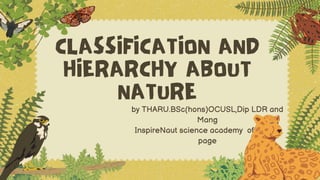
EVOLUTION TUTE 2.pptx
- 1. by THARU.BSc(hons)OCUSL,Dip LDR and Mang InspireNaut science academy official fb page
- 2. Just like nature, we encounter interesting words everywhere!
- 3. • The arrangement of organisms into groups based on common characteristics is called classification. Taxonomy is the scientific study of classification, identification, nomenclature, and description. This involves placing groups of organisms in a hierarchical sequence.
- 4. • Artificial Classification: ⚬ Grouping is based on a few pre-selected unifying characters. ⚬ Characters are selected for convenience, and organisms are grouped based on these criteria. ⚬ Evolutionary relationships are ignored. ⚬ Only system used before the 18th century. ⚬ Easy to use and expand by adding more groups. ⚬ Examples: Plants classified as cereals, ornamental plants, medicinal plants, poisonous plants; Animals classified as two- legged, four-legged, six-legged, eight-legged, etc. Natural Classification Artificial Classification
- 5. Grouping based on true relationships, representing evolutionary relationships based on phylogeny. Developed after the study of evolution. Based on various characteristics like morphological, anatomical, cytological, or molecular biological. Examples: Plants classified into phyla (Bryophyta, Lycophyta, Pterophyta, Cycadophyta, Coniferophyta, Anthophyta); Animals classified into Cnidaria, Platyhelminthes, etc.
- 6. • Early classification systems were artificial and based on human uses. • Aristotle was the first to classify organisms scientifically, dividing them into plants and animals. • Carolus Linnaeus introduced binomial nomenclature and classified about 6,000 plants into hierarchical taxa. • With the discovery of microorganisms, Ernest Haeckel introduced the kingdom Protista. • Robert H. Whittaker introduced the five-kingdom system based on cellular organization and mode of nutrition. • Carl Woese introduced the three-domain system (Bacteria, Archaea, Eukarya) based on molecular biology and evolutionary relationships.
- 7. • Modern systematics use molecular biology for taxonomic criteria. • Criteria include DNA base sequences, mitochondrial and chloroplast DNA sequences, ribosomal RNA base sequences, amino acid sequences, and molecular structure of cellular components. • Kingdom Protista is considered artificial, and viruses are separate due to lack of cellular organization.
- 8. • Taxonomic units at different levels are called taxa. • Each taxon has a rank and a name (e.g., Panthera at the genus level, Mammalia at the class level). • Domains are divided into kingdoms, kingdoms into phyla, and so on, with many subcategories.
- 9. • A species is a group of organisms sharing similar characteristics that can interbreed and produce viable and fertile offspring. • Other definitions include morphological, ecological, and phylogenetic species concepts.
- 10. • Proposed by Carolus Linnaeus, it uses a two-part name: generic name (noun) and specific epithet (adjective). • Examples: Homo sapiens (man, intelligent), Dipterocarpus zeylanicus (fruit with two wings, endemic to Sri Lanka), Dipterocarpus grandiflorus (fruit with two wings, large flowers). Related species have the same generic name with different specifi c epithets. e.g. Dipterocarpus zeylanicus and Dipterocarpus grandifl orus Dipterocarpus zeylanicus means fruit with two wings, and endemic to Sri Lanka. Dipterocarpus grandifl orus means fruit with two wings and having large fl owers.
- 11. when scientists name living things, they follow certain rules called "International Codes of Binomial Nomenclature." These rules are a bit different for plants, animals, bacteria, and viruses. Here are some important rules: • Unique Names: No two different species can have the same name. • Two Parts in a Name: Each species has a special name made up of two parts. One part is the general name (like a family name), and the other part is the specific name (like a personal name). Together, they make up the scientific name. • Latinized Words: The names are made up of Latinized words, written in the Roman script (like the letters we use). • Formatting: When writing by hand, the name should be underlined. When printed, it should be italicized. The first letter of the general name is a capital letter, and the specific name is in regular letters. • Author's Name: In scientific writing, the person who gave the name is mentioned with a capital letter, an abbreviation, or the full word at the end of the name. This part is not in Latin. For example, "Cocos nucifera L." (L stands for Linnaeus). • Subspecies or Variety: Sometimes, a third word is used to represent a subspecies or a variety. For instance, "Panthera parduskotiya" represents a Sri Lankan leopard.
- 12. Use of Keys: Scientists use keys to group and identify organisms. These keys don't show how different species are related evolutionarily. EXAMPLE 1: SILVERFI SH, BUTTERFL Y, HOUSE FL Y, BEETLE 1. POSSESSES WINGS …………………………………………………. (2) DO NOT POSSESS WINGS ………………………………………….. SILVERFI SH 2. POSSESS TWO PAIRS OF WINGS …………………………………… (3) DO NOT POSSESSES TWO PAIRS OF WINGS………………………………HOUSEFL Y 3. POSSESSES A PROBOSCIS ……...………………………………....BUTTERFL Y DO NOT POSSESS A PROBOSCIS ………………......…….............,.BEETLE NOT HAVING A RADIALLY SYMMETRICAL BODY …………...…… … ……..(2) 2. POSSESS LEGS……………………....…………………………………(3) DO NOT POSSESSES LEGS ……………………………………………...(4) 3. WINGS PRESENT………………………………………................. BUTTERFL Y WINGS ABSENT……...…………………………………................ FROG
- 13. Domains There are three domains. They are; a) Domain – Bacteria- consists of one kingdom. Kingdom - Bacteria b) Domain –Archaea-consists of one kingdom. Kingdom - Archaebacteria c) Domain –Eukarya-consists of four kingdoms